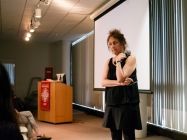
Liz Lerman presents “An Artist’s Life at the Border”
During her stay as a researcher here at UMBC, Liz Lerman shared her thoughts and stories in the hopes of inspiring and opening the minds of others.
Instead of different fields of study, such as art and science, working separately, Liz Lerman questioned how they can work together. Lerman is a choreographer, performer, writer, educator and speaker. On Thursday, April 16, she gave a talk titled “An Artist’s Life at the Border” in the library’s gallery.
In 1976, she founded the Liz Lerman Dance Exchange, an intergenerational company of artists that strives to create unique dances, and engage others in embracing the arts. One of their goals is to break the boundaries between the stage and audience. Lerman has passed on her role as the director to Cassie Meador, who is also a choreographer, performer and educator.
“[The Dance Exchange] is interested in who gets to dance, where the dance is happening, what it is about and why does it matter,” said Lerman. Altogether, the organization hopes to collaborate with different fields of study and bring ideas into action. Today, Lerman is pursuing new projects while working on campus with the Imaging Research Center.
Lerman is interested in developing a new way of thinking about existing information with a special focus on information and methods that derive from practice. “I am working on an online system that would allow users to find creative tools to help them achieve whatever they are trying to do,” she said.
Shortly into the talk, it became clear that she places a high value on nurturing one’s inquisitive nature. She wonders how our own ideas are sharpened when we extend ourselves outside of our disciplines and comfort zones.
“When we wander outside of our home or our refuge, I wonder what happens to us and how are we able to contribute to things differently in the world,” said Lerman. She believes in exploring what’s out there and collaborating with others in order to gain a sense of a world of possibilities.
“I want people to think and I want them to realize that there is more than one way to reach their own goals. I want them to realize that creativity lives at the borders between worlds, ideas and methods,” said Lerman. She stresses the significance of letting one’s imagination go wild and straying away from this belief that there’s only one right way to do something.
Anthony Alberti, a freshman English major, said, “I really liked hearing about her past, especially her theatre company. I enjoyed her ideas about creative research and how art and science intersect and aren’t totally different worlds.”
The talk was sponsored by the Dresher Center for the Humanities. The Director, Jessica Berman, said, “I thought the talk was a wonderful example of what can happen when scholars, artists, or researchers think beyond the borders we set up between disciplines or practices.” She asked Lerman to share her stories.
One of Lerman’s interesting stories was about visiting Japan with her dance company. During a conversation with a Japanese man, she learned that he didn’t want any more American influence in his country. By turning the man’s statement into a question, Lerman then began to wonder when and why we want to, or don’t want to, accept an influence.
“I came to Japan in order to be influenced, but there have been times in my life where I didn’t want that,” Lerman said. With this, she questions when it is okay to be open to influence and where and when do we observe the influence within research.
Immediately after Lerman concluded her talk, a line of students and faculty members formed, all seemingly eager to share their thoughts with Lerman and hear more of her inspiring words.
Photo Credit: Patrick Alejandro
Read more stories from: The Retriever Weekly





